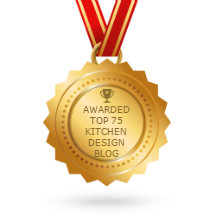

So, you have a brand-new white kitchen and you splatter some pasta sauce on your cabinetry. What now? Do you grab a bleach wipe? Do you spray it down with all-purpose cleaner and wipe it off with a kitchen towel? Do you let it sit on there until you are done cooking and then spray a water-vinegar solution on the cabinets and then wipe with a sponge?
If you do any of these things, you are going to damage your cabinetry finish immediately and the damage will get worse over time. As a seasoned kitchen designer, I am appalled to find that many homeowners are being sold new cabinetry without being properly educated on the care and maintenance of their purchase. I am here to give you some tips on what to do (and not to do!) with regards to cleaning your cabinetry.

Most spills can be cleaned up with a dry or slightly damp microfiber cloth. What could be easier? These versatile cleaning clothes are available everywhere in many colors. You could have some designated for the cabinetry, another color for other kitchen uses, a different color for the bathroom, and still another color for general dusting around the house.
Regularly dust off your cabinetry with a dry microfiber cloth. Most cabinet grime doesn’t appear overnight but is the result of buildup of dust and food particles over time. Removing this dust and debris before it has a chance to settle into the grooves of your cabinets will help prevent staining and mitigate the need for heavy duty cleaning.
Keep your cabinets dry. Almost 70% of new cabinets sold now have a painted finish. Those doors are made up of wood and medium density fiberboard. If water is allowed to sit on the cabinets for a period of time, it will inevitably penetrate the finish into the wood underneath and cause bubbling, cracking, or peeling of the painted finish. This is particularly important to pay attention to on your sink cabinet and your trash cabinet, as those get the most exposure to water and wet items. When you are done washing dishes, make it a habit to just wipe down the front of your cabinet with a clean microfiber cloth to keep that painted finish looking nice as long as possible.
If a deeper cleaning is needed, use only a clean damp microfiber cloth to wipe the cabinets and then dry them off really well with a second microfiber cloth. Kitchen towels and sponges that you use for many things are not good to clean the cabinets with since they typically have soap residue or cooking grease on them. Beware a sponge with textured material intended for scrubbing because it could remove any protective coating your cabinets have on them.

Don’t use any type of cleaning agent on your cabinets, such as furniture polish, soap, dishwashing liquid, so called cabinet cleaners, bleach or ammonia-based wipes, all-purpose cleaners, beeswax, or anything that has not been specifically approved by the cabinetry manufacturer. Cleaning agents have chemical compounds that can change the color of your cabinets and make them more prone to blistering or peeling.
Don’t leave a spill to linger. If you spill or splatter tomato sauce, wine, coffee, fruit juice, or condiments wipe it up immediately. Acid-based foods in particular can corrode your cabinet finish quickly!
Don’t neglect to use your range hood. When you are cooking, it is very important to turn on your range hood to remove food, spice, and oil particles from the air, so they do not settle on the surrounding cabinets.
Prevention is the absolute best way to keep your cabinetry clean. It’s easy to clean up any spills or splatters when they happen with a handy supply of microfiber cloths. This good habit also saves you time in the long run as it protects your cabinets from damage.
PRO TIP: Ask your designer to order you an extra touch up kit, so you can apply it to any cabinet scratches or dings that occur with normal use and keep that new kitchen looking beautiful for a long time.
Mary Jane Robillard
Kitchen Views, 3356 Post Road, Warwick, RI 02886























